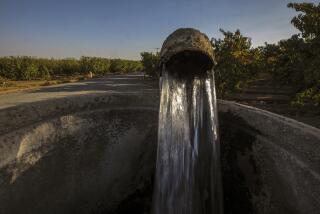Local Agencies Seek Control of Proposals to Ration Water : Drought: Trying to apply conservation measures equitably to the entire state is impractical, board members are told. Plan to limit domestic water use to 300 gallons per household is criticized.
- Share via
SACRAMENTO — Resisting solutions proposed by state bureaucrats, the groups with the most at stake in California’s continuing drought urged water officials Tuesday to leave the painful details of water rationing to local authorities.
As bone dry weather propels the long California drought into its fifth year, farmers, industrial users and local water agencies told the State Water Resources Control Board that it would be impractical and nearly impossible to devise strict conservation measures that could apply equitably to the entire state.
Local water agencies took aim specifically at a proposal to limit domestic water use to 300 gallons per household per day, saying it failed to account for varying sizes of families and different weather and water conditions in different parts of the state. Studies show that normal water use for a single person ranges from 100 to 200 gallons daily.
“There are just so many variations, so many intricacies that it’s a mistake to try to have general rules to apply to everybody. People that live in Riverside are going . . . to use a lot more water than people living in Santa Monica,” said Carl Boronkay, general manager of the Metropolitan Water District, noting the differences in water use between coastal and inland regions. A water wholesaler, the MWD serves 300 Southern California communities and supplies about 60% of the water used by the city of Los Angeles.
The best judge of how to allocate scarce water supplies are local water districts, most of which have already started water rationing programs, said John P. Fraser, executive director of the 400-member Assn. of California Water Agencies.
His comments were prepared for delivery at a hearing on 18 water conservation proposals put forth by the state board to draw attention to the severity of California’s drought. Besides the limitation on personal water use, the proposals include plans to severely reduce water allocations to agriculture.
The hearing attracted 700 water officials, more than have attended any other airing of water issues. It is to continue today.
The board, which has regulatory authority over all surface water, will decide Feb. 7 what kind of water conservation measures it will impose and whether it will be willing to allow local agencies to determine water rationing methods. The four-member board is made up of appointees of former Gov. George Deukmejian.
Los Angeles and MWD officials said the board could set general conservation goals for each district but it should leave to the discretion of local agencies to determine how those goals would be met.
“We think the idea of mandatory conservation is good,” said Ron Cagle, legislative representative for Los Angeles. “We don’t think one size fits all. It (the 300-gallon limit) doesn’t account for local climate conditions, local economic conditions or local ground-water supplies.”
Farmers, who already face severe cutbacks in water deliveries, said proposals to give irrigation priority to perennial crops and then only at survival levels could prove “an economic disaster” particularly to areas of the state where row-crop production is the base of the local economy.
“Not only are the farmers affected, but the local communities as well; from the farm worker to the seed dealer to the banker and other support services,” said Mary Ann Warmerdam, natural resources director for the California Farm Bureau.
Farmers already have been targeted by the State Department of Water Resources to bear the brunt of water cutbacks. If drought conditions continue this year or if spring rainfall is only at normal levels, officials said all deliveries from the state Water Project to agriculture will be cut off.
Farmers and local officials suggested the board could ease some effects of the drought by removing bureaucratic red tape associated with implementing water transfers or moving water from areas which have surpluses to those in need.
RATIONING OUTLOOK FOR STATE WATER
Depending on the amount of rain that falls between now and the end of the winter/spring season, officials expect to reduce water flowing to agricultural and residential users from the state Water Project--one of California’s main water sources. Although the reductions could completely shut off agriculture’s allocations, many regions, including Los Angeles, have alternative water sources. Farmers in the San Joaquin Valley, for instance, can draw from the federal government’s giant Central Valley Project.
WATER DELIVERY CUTS WATER DELIVERY CUTS RAINFALL AMOUNT TO AGRICULTURE TO CITIES AND INDUSTRIES * Below normal 100% 85% * Normal 100% 50% * Above normal 50% No cuts
More to Read
Sign up for Essential California
The most important California stories and recommendations in your inbox every morning.
You may occasionally receive promotional content from the Los Angeles Times.













